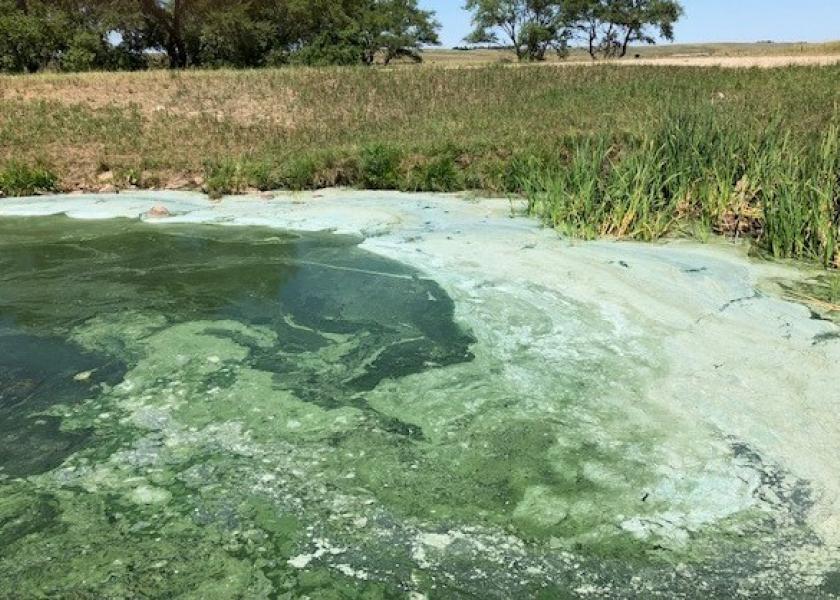Drought Conditions Favorable for Toxic Cyanobacteria

Cyanobacteria, also known as blue-green algae, can produce toxins that are harmful to livestock, wildlife and people.
The growth of this bacteria is aided by high temperatures.
“The hot, dry conditions we are experiencing are perfect for the production of cyanobacteria,” says Miranda Meehan, North Dakota State University Extension livestock environmental stewardship specialist. “Much of the state is at an increased risk due to the widespread drought affecting 99% of the state.”
Given the current conditions, producers and the public should be on the lookout for cyanobacteria blooms.
Blue-green algae often occurs in stagnant ponds or dugouts with elevated nutrient levels, forming large colonies that appear as scum on or just below the water surface. Live cyanobacterial blooms can be green, but also red or yellow, and often turn blue after the bloom dies and dries on the water surface or shoreline.
Some species of cyanobacteria can be toxic when livestock and wildlife ingest them. Toxicity is dependent on the species consuming the water, the concentration of the toxin or toxins and the amount of water ingested.
“Cyanobacteria can produce neuro and liver toxins,” says Gerald Stokka, NDSU Extension veterinarian. “Signs of neurotoxin poisoning can appear within five minutes to up to several hours after ingestion. In animals, symptoms include weakness, staggering, muscle tremors, difficulty in breathing, convulsions and, ultimately, death.”
Animals affected by liver toxins may exhibit weakness, pale-colored mucous membranes, mental derangement, bloody diarrhea and, ultimately, death. Typically, livestock are found dead before producers observe symptoms. If cyanobacterial poisoning is suspected as the cause of death, producers should check the edges of ponds for dead wildlife.
When collecting a water sample, follow NDSU Extension’s “Livestock Water Testing Guidelines” (https://tinyurl.com/NDSU-LivestockWaterTesting). Contact your local Extension agents for a sampling container or assistance with collecting samples.
Be sure to wear gloves because cyanobacteria can be toxic to humans. Collect a sample of the suspected cyanobacterial bloom from the surface of the water and deeper in the water. The sample should be kept cool but not frozen, and submit it to the NDSU Veterinary Diagnostic Laboratory or a commercial laboratory.
The sample can be evaluated microscopically for algae, or the water can be analyzed for several of the toxins at commercial labs at a higher cost.
For more information on sample collection and submission, contact your NDSU Extension agent.
Here are some ways producers can prevent cyanobacterial poisoning of livestock:
* Reduce nutrient levels entering the water source by implementing a nutrient management plan or establishing buffer strips with perennial plant species.
* Create a designated drinking area where the risk of cyanobacteria is minimal.
* Fence off the pond and pump water from the pond to the water tank.
* Use water from other sources following periods of hot, dry weather.
* Pump water from the center of the water body well below the surface, where the bacteria are unlikely to concentrate, to a water tank.
If a producer suspects cyanobacteria poisoning as the cause of a livestock death, a veterinarian should conduct a necropsy. Contact your veterinarian to determine which samples would be appropriate for your situation.
Livestock loses due to cyanobacteria during drought may be eligible for compensation through the U.S. Department of Agriculture’s Livestock Indemnity Program. Contact your local Farm Service Agency office for more information.







